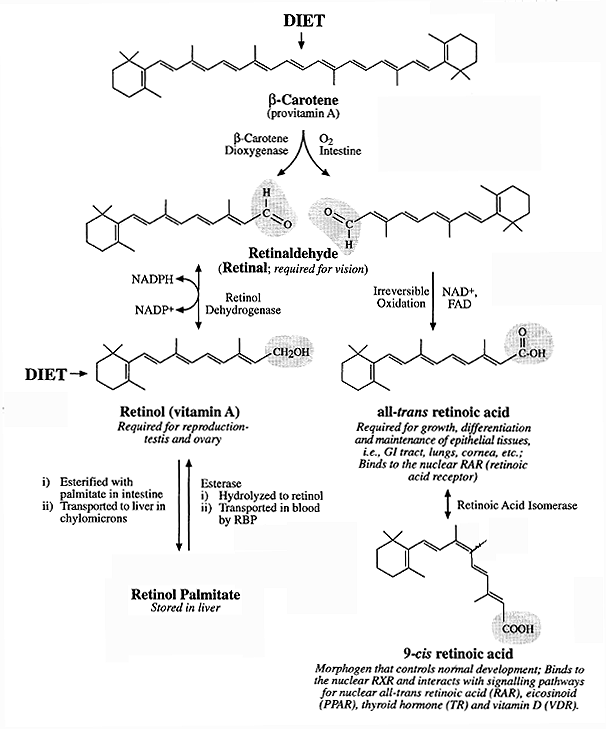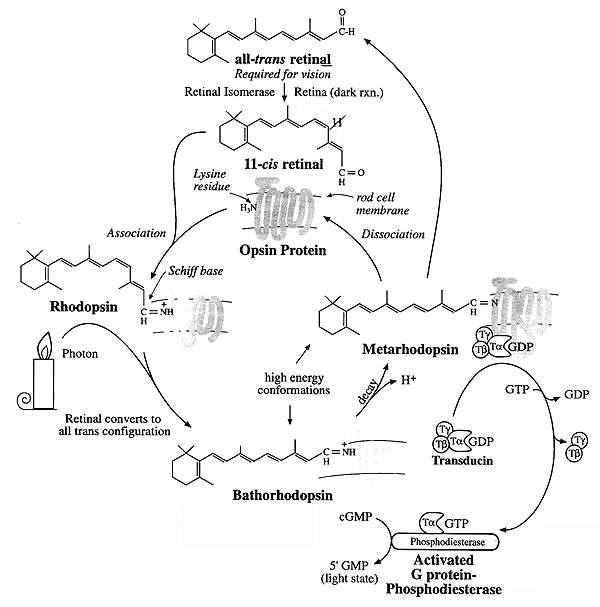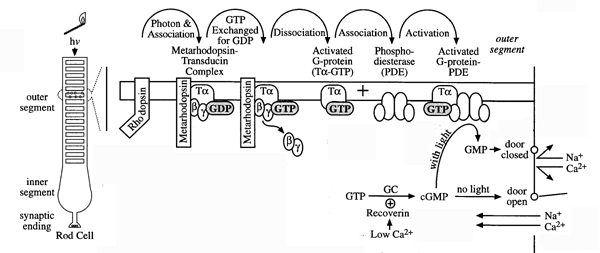
Vitamin A and Vision
Physiology: Vitamin A plays at least two distinct roles in humans: maintenance of vision and differentiation / growth of epithelial cells at a genetic level.
Active Forms of Vitamin A: retinol (OH), retinal (HC=O), and retinoic acid (CO2H)
Sources: Precursors are synthesized by plants as the carotenoids, which are cleaved, reduced, esterified and stored in the liver as retinol palmitate. Dark green, leafy vegetables and orange / yellow vegetables and fruits are good sources of the carotenoids.
Liver, egg yolk, butter and whole milk are good sources of retinol.
Carotenoids and retinol are absorbed along with other lipids in the diet.
Deficiency:
USA- in patients with fat malabsorption syndromes.
Third World:
(1) Night Blindness (when liver stores are nearly exhausted)
(2) Keratinization (of epithelial tissue: eyes, lungs, gastrointestinal tract)
(3) Xerophthalmia (corneal dryness, loss of reflective power)
(4) Blindness
(5) Keratomalacia (perforation of the cornea followed by bacterial invasion)
(6) Death
The Chemistry, Metabolism and Functions of Vitamin A:

The Participation of Retinal in the Visual Cycle:


Note: Owls have all Rods making them able to see well in low intensity light (at night), pigeons have all cones make them virtually blind at night but also giving them color vision.
The Visual Cycle: https://en.wikipedia.org/wiki/Visual_phototransduction
Vitamin A Toxicity:
Vitamin A is a fat soluble vitamin so excesses can not be easily excreted as in the case of water soluble vitamins (which are very rarely toxic).
Occurs when the capacity of RBP has been exceeded and the cells are exposed to unbound retinol.
The reasons that vitamin A can be toxic and exactly how it produces such global cellular changes are complex and not well understood.
Symptoms of Toxicity:
Bone pain, Dermatitis, Enlargement of Liver and Spleen, Diarrhea
Diarrhea / Dermatitis: epithelial cells shed (exfoliate) this includes skin, lungs, intestinal
Bone Pain: craniofacial and neural tube malformations, regulation of gene expression (via induction and repression) goes hay-wire
How Vitamin A (retinoic acid, gene expression) Receptors Fit Into the Superfamily of Retinoid, Thyroid and Steroid Hormone Nuclear Recpetors:
General Structure of the Receptors

Nuclear Receptors in the Gonads increase gene expression and maintain reproductive tissues while nuclear receptors in epithelial cells regulate cell differentiation.
© Dr. Noel Sturm 2019